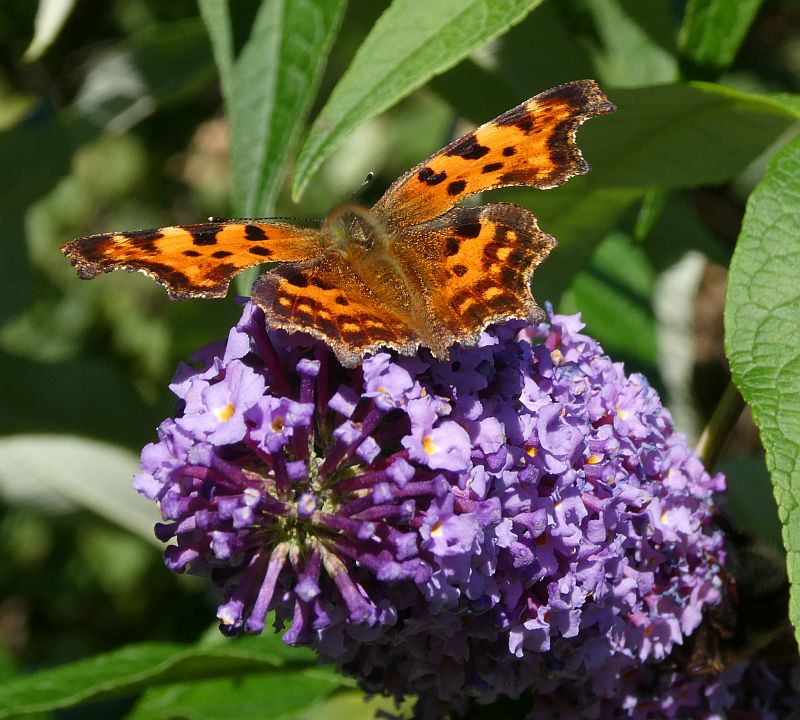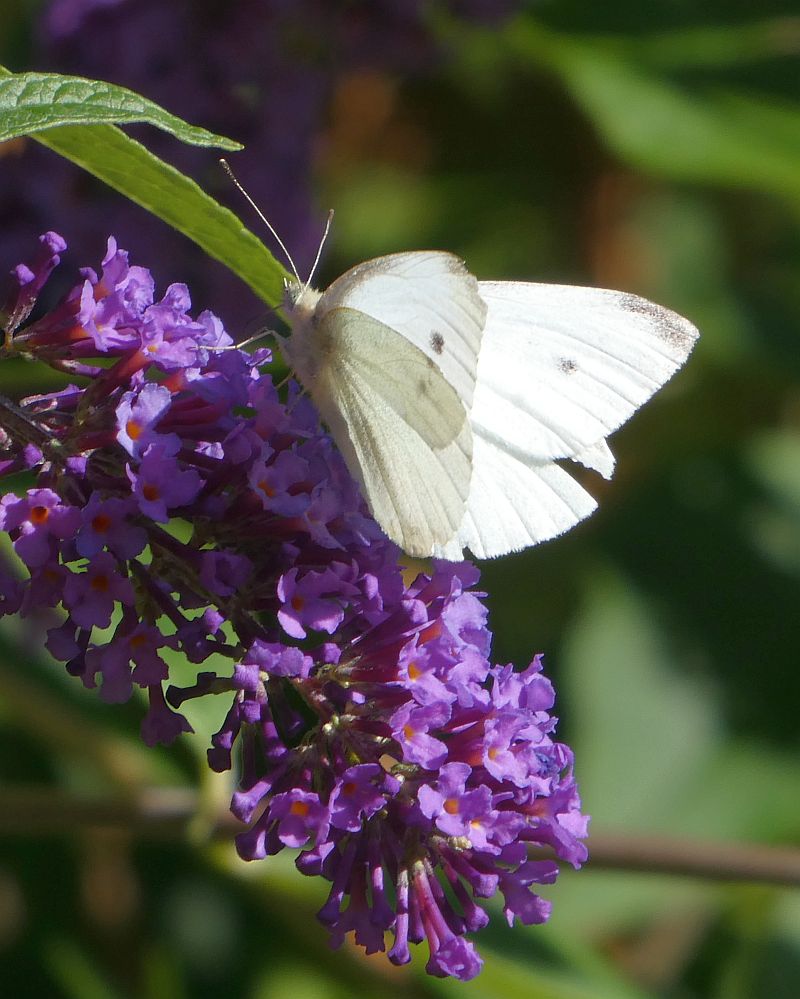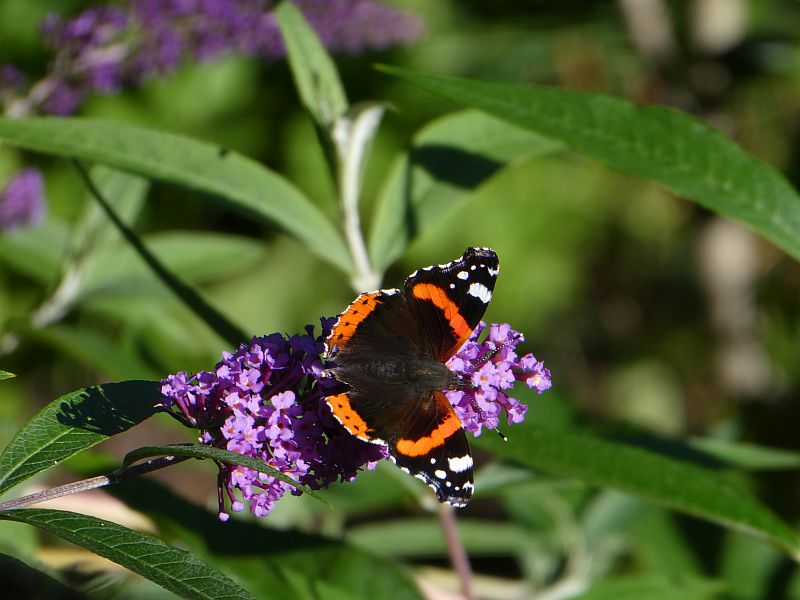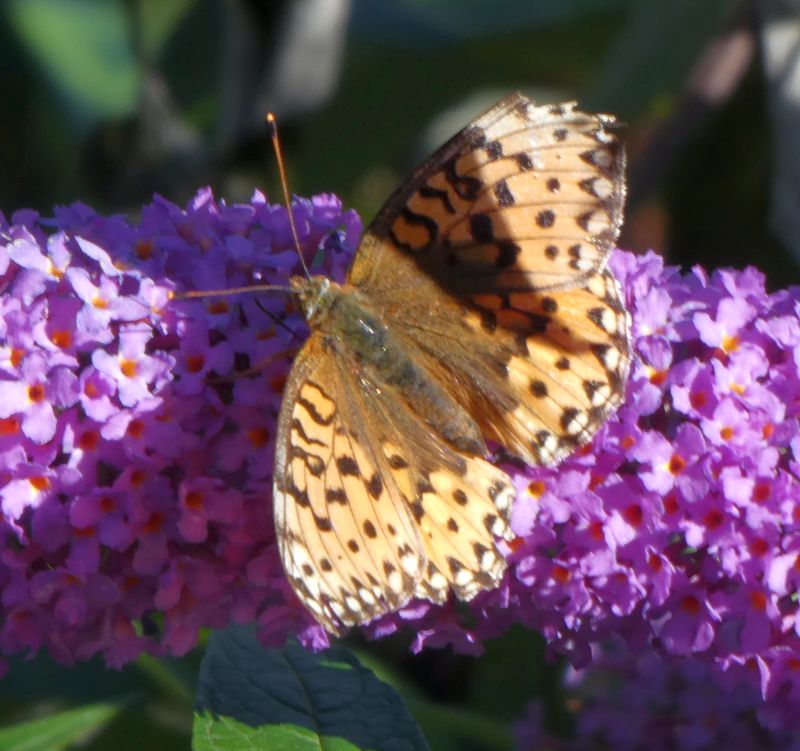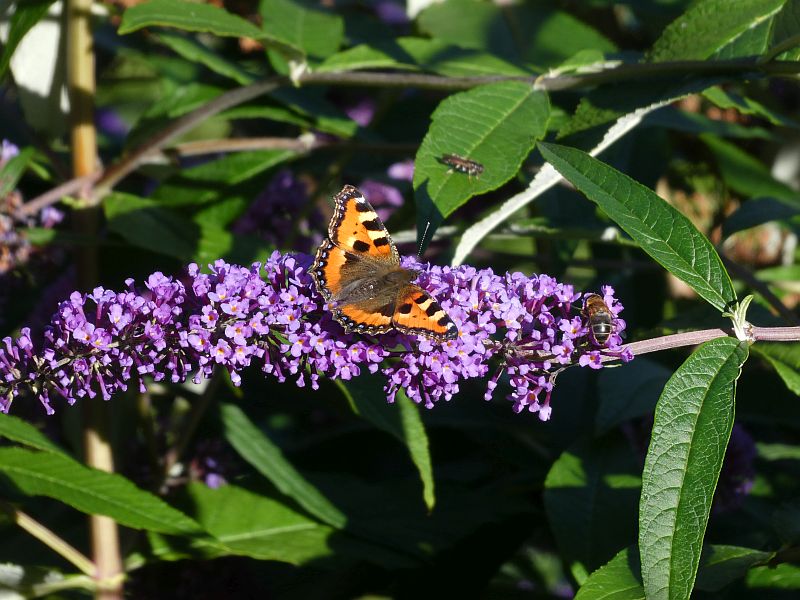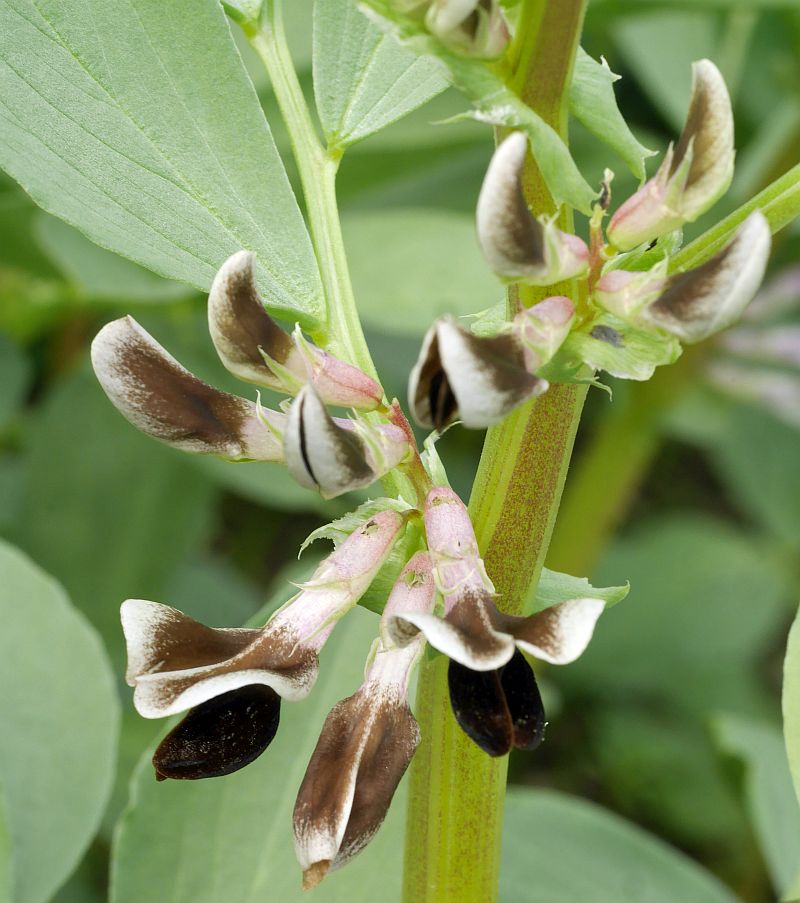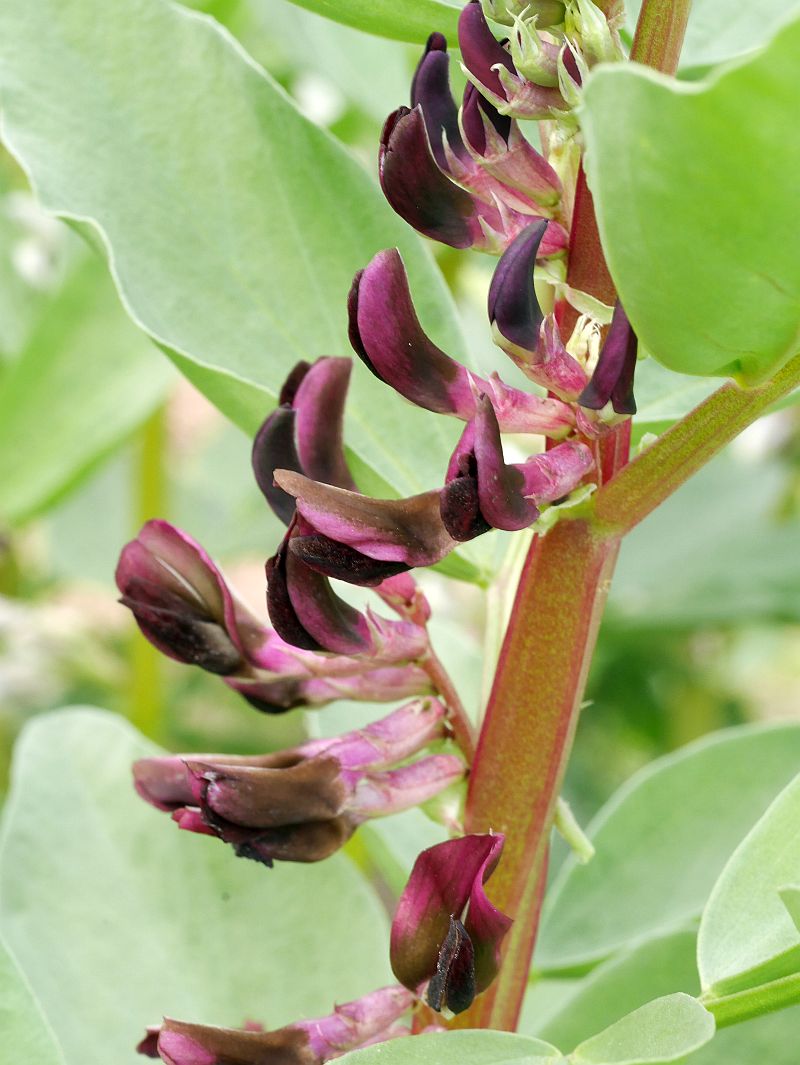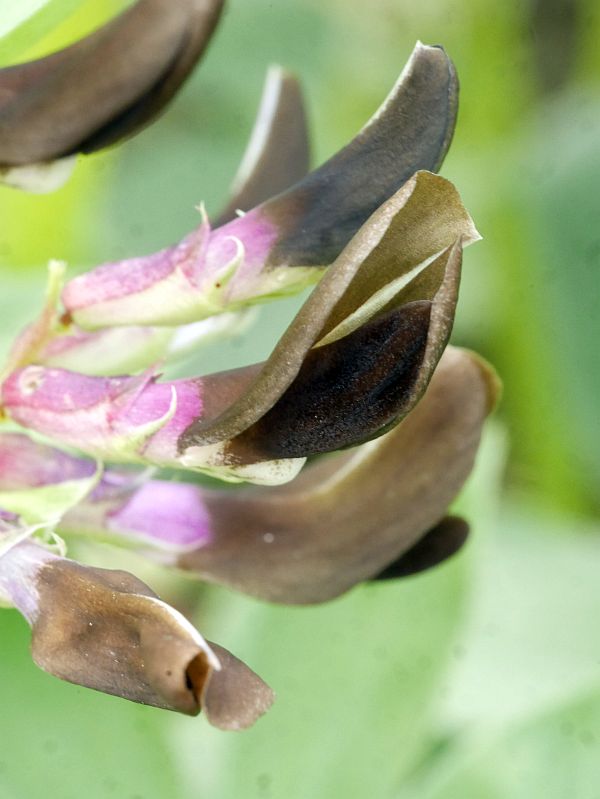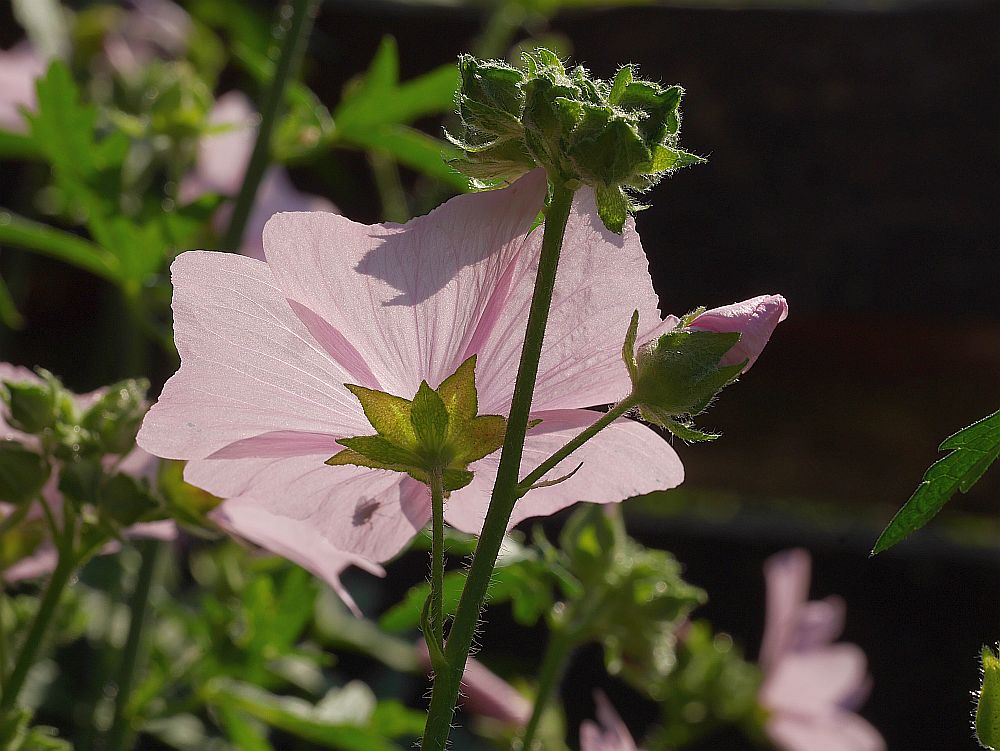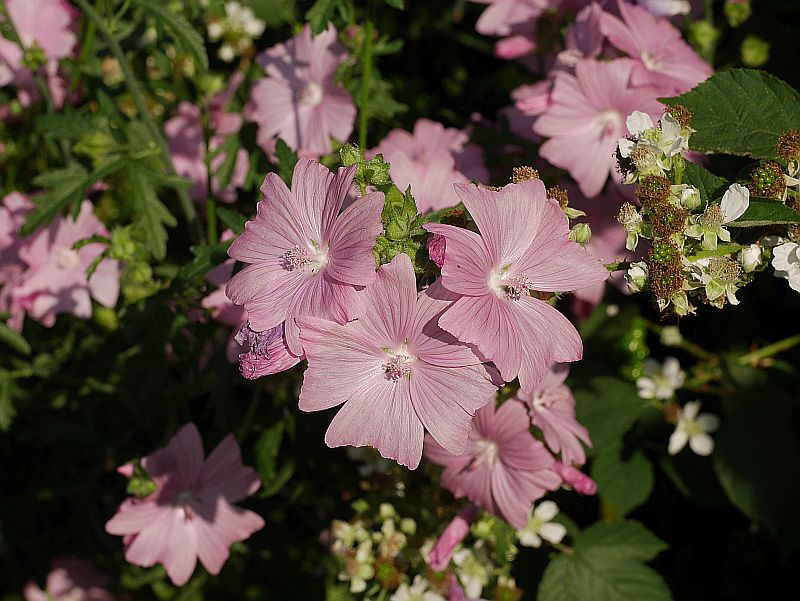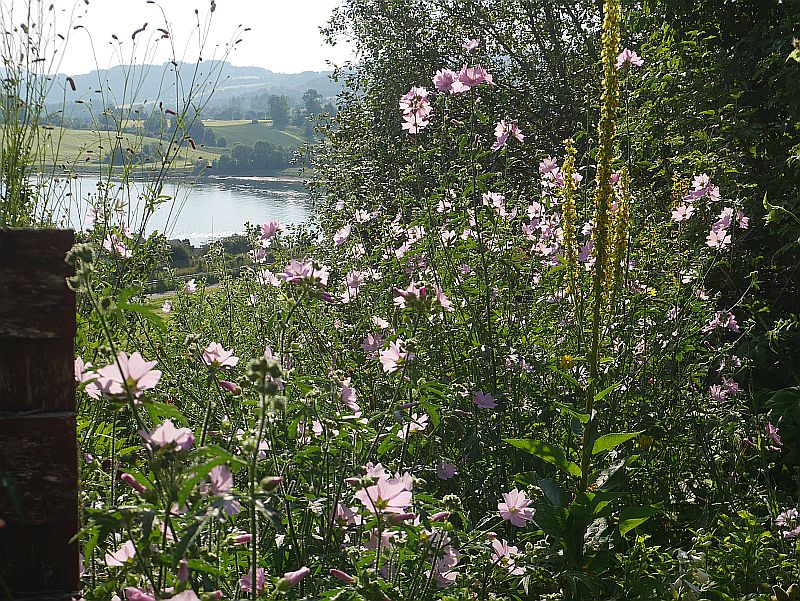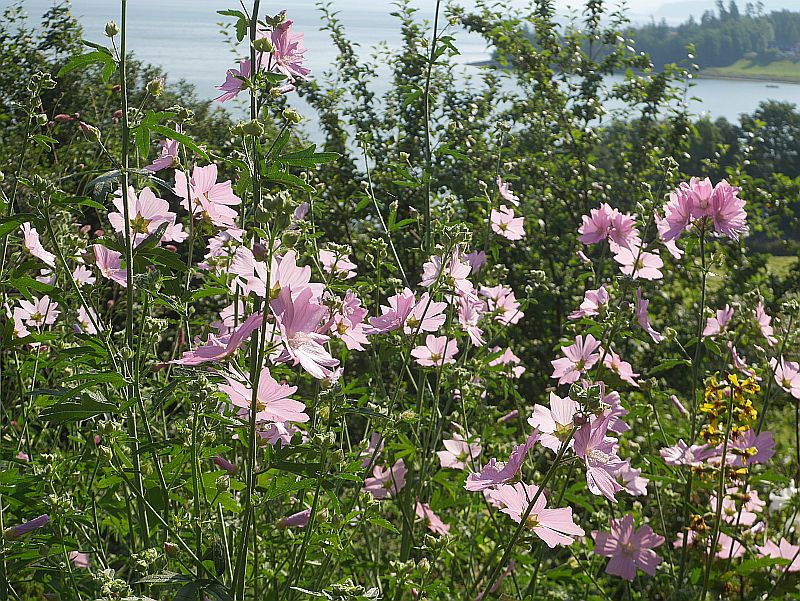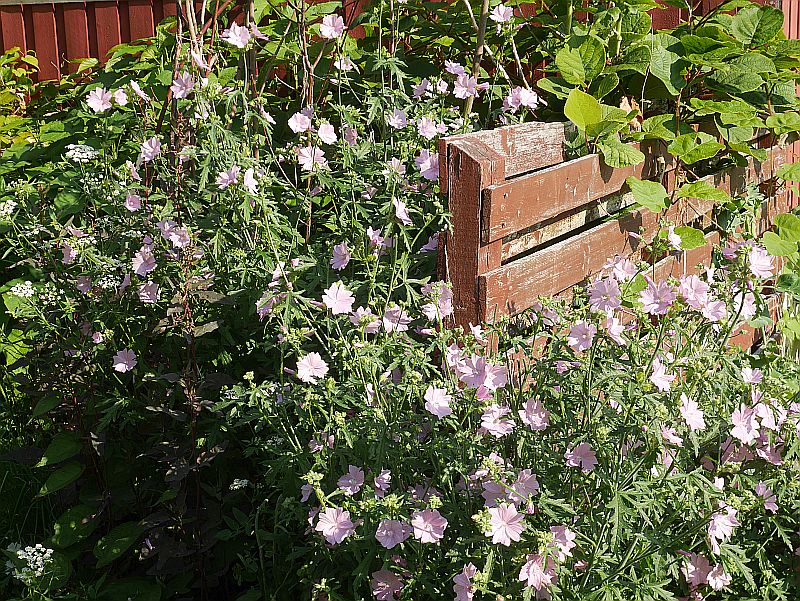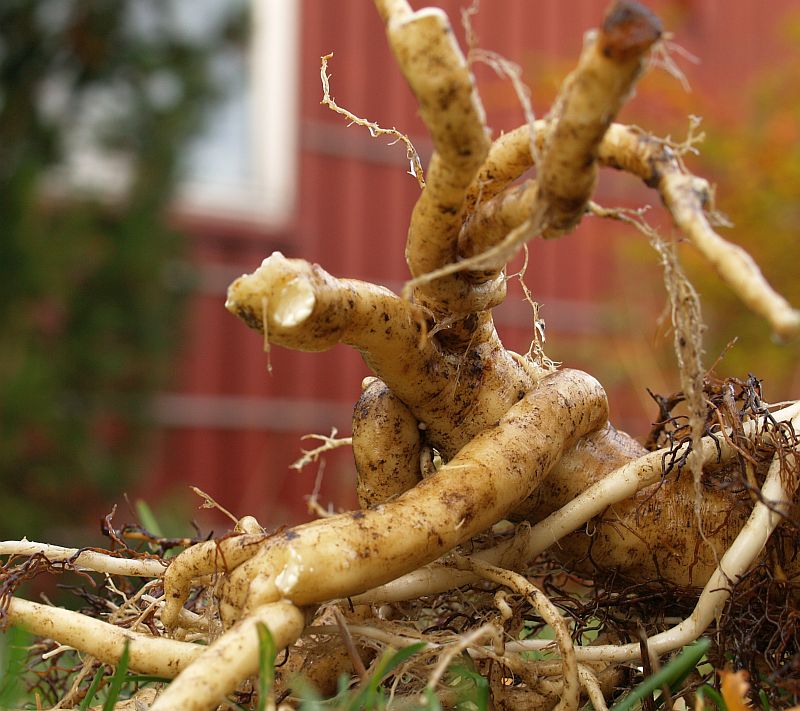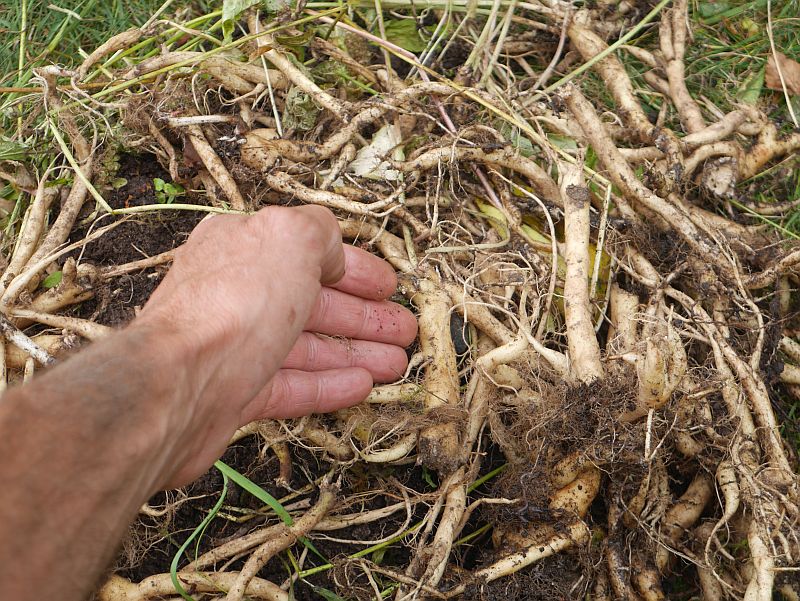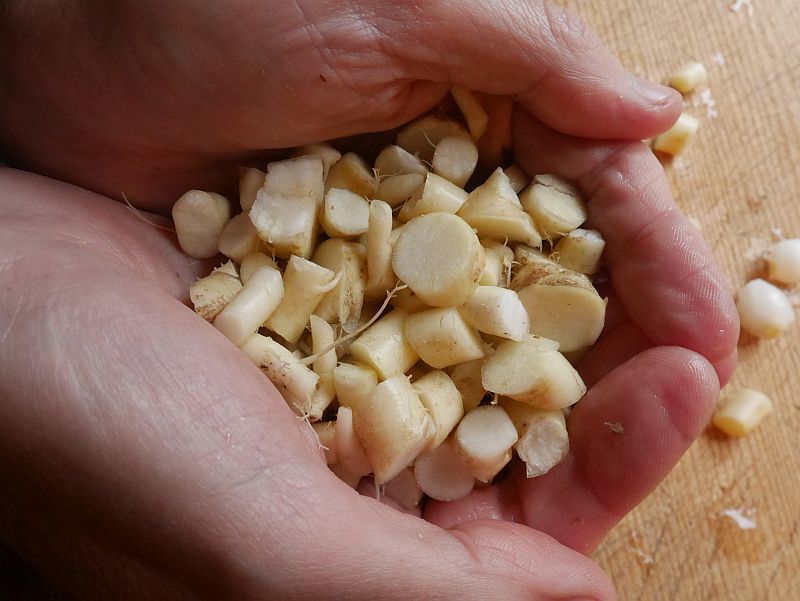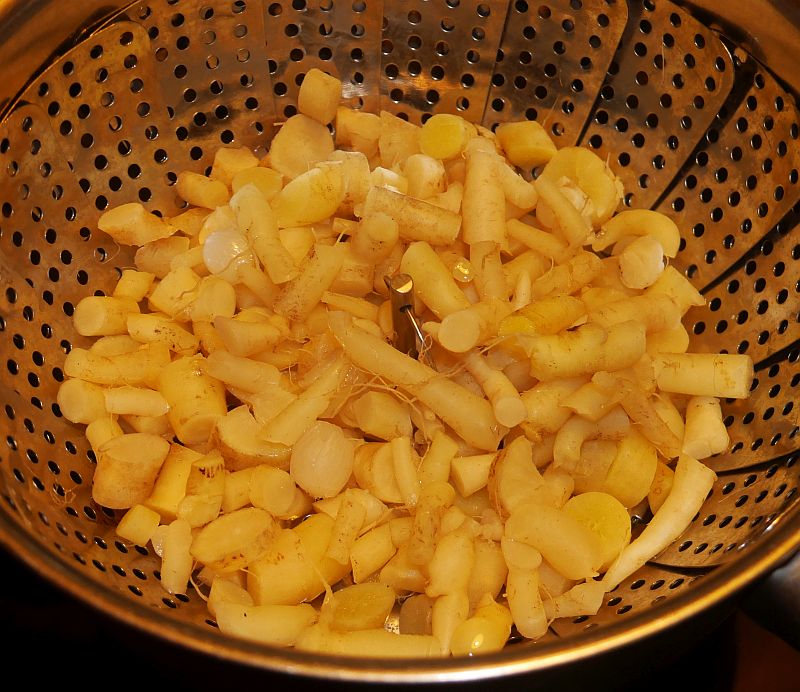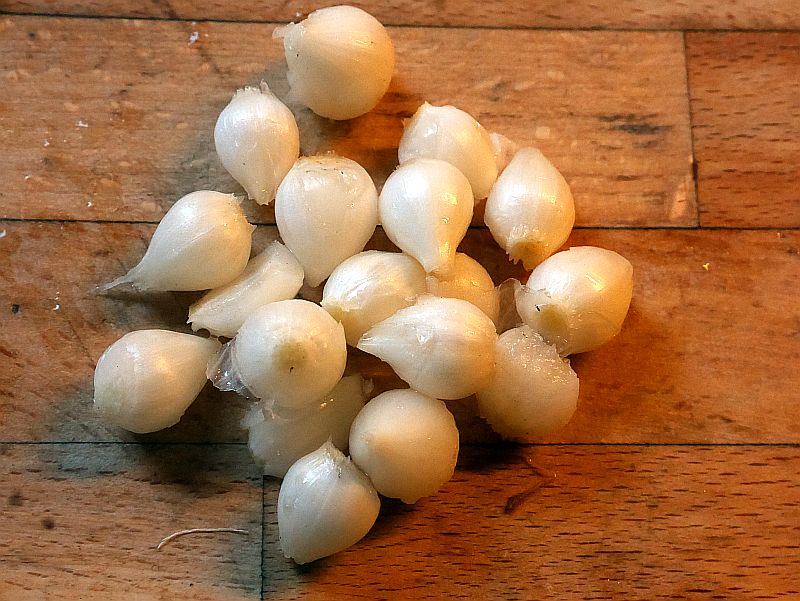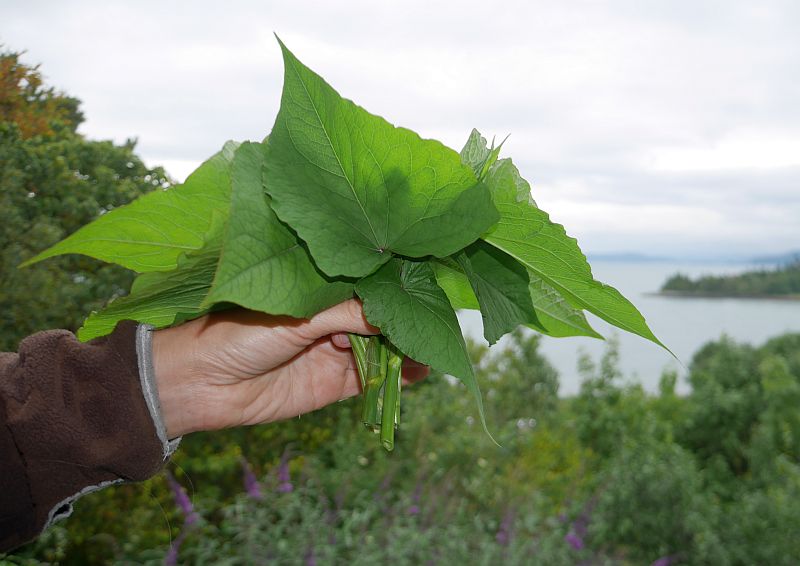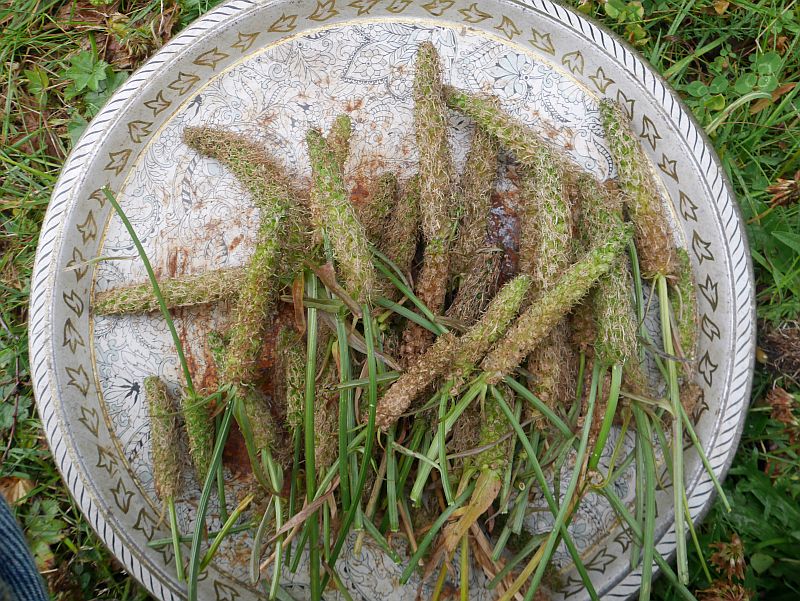By chance, the best two plants in the garden for pollinating insects in late summer are growing together in the garden. The Clematis vitalba (old man’s beard / tysk klematis) is in the foreground in the picture below and is popular with hoverflies, droneflies and bumblebees. Behind is my largest (of 3 Buddlejas, butterfly bush /sommerfuglbusk). We had one when we were growing up in the back garden, where my interest in insects and nature started. As the name suggests, it is most popular with butterflies (and moths), but bumble bees are also commonly seen on it. The Clematis reaches up to the balcony which allows me to study the insects at close hand. Clematis vitalba was planted in the garden as the cooked young shoots are commonly eaten in spring in Italy and is therefore one of the best edientomentals (edible/for the insects/ornamental) you can plant. Buddleja davidii is not edible and is in the entomental category.
Although the total number of butterflies is lower this year as last year we experienced a major invasion of painted lady (tistelsommerfugl) butterflies (only 2 observations in the last month in this part of Norway), there is a good diversity of species and you’ll find pictures and videos of the following species below:
Red admiral / admiral (up to 4)
Small tortoiseshell / neslesommerfugl (7)
Dark green fritillary / aglajaperlemorvinge (1)
Brimstone / sitronsommerfugl (colonising this area and my 3rd record this summer)
Comma / hvit C
Small white? / liten kålsommerfugl
Green-veined whites / rapssommerfugl have also been very common this year.
A possible small blue (dvergblåvinge) was also seen in the garden on Allium wallichii on 21st August.
Category Archives: Edientomental
Broad Bean Mix
Broad beans (favas / bondebønner) will easily cross with other varieties that are growing nearby. In order to keep a variety pure, you need to isolate them physically. I like to have different varieties with different coloured flowers and bean colour in additon to maintaining early yielding varieties such as Express. I’ve found that I can plant different forms close together and if I save separately beans with different colour and bean size and mark for saving plants with particularly nice flower colours, then I can maintain a good mix in the same place. The flower forms below are all growing within a few metres in the Væres Venner community garden. They were grown from the mix of beans saved at the same place in 2018 (first picture). I don’t offer the different forms as named varieties, but as a mix or composite “Væres Venner Mix” so that others can also select for separate forms! Bumble bees were all over the flowers when I was there!
Red-tailed bumblebee: new species for the garden
Yesterday, I registered red-tailed bee / steinhumle (Bombus lapidarius) for the first time at the community garden (Væres Venner), the first time in this part of Trondheim. This is a common species in the city and is probably the commonest bumblebee in the Allium garden at the botanical gardens. Today, I saw this species for the first time in my own garden, the first record in this area. It was on Allium pskemense, probably the most popular plant in my garden for bumblebees. In the second video you can see both the white-tailed bumblebee (Bombus lucorum; lys jordhumle) and tree bumblebee (Bombus hypnorum; trehumle). Please correct me if I’m wrong!
Bee beetle on the first Sanguisorba flower
It’s always nice to spot a bee beetle / humlebille (Trichius fasciatus) in the garden. I discovered this one on the first Sanguisorba flower of the year!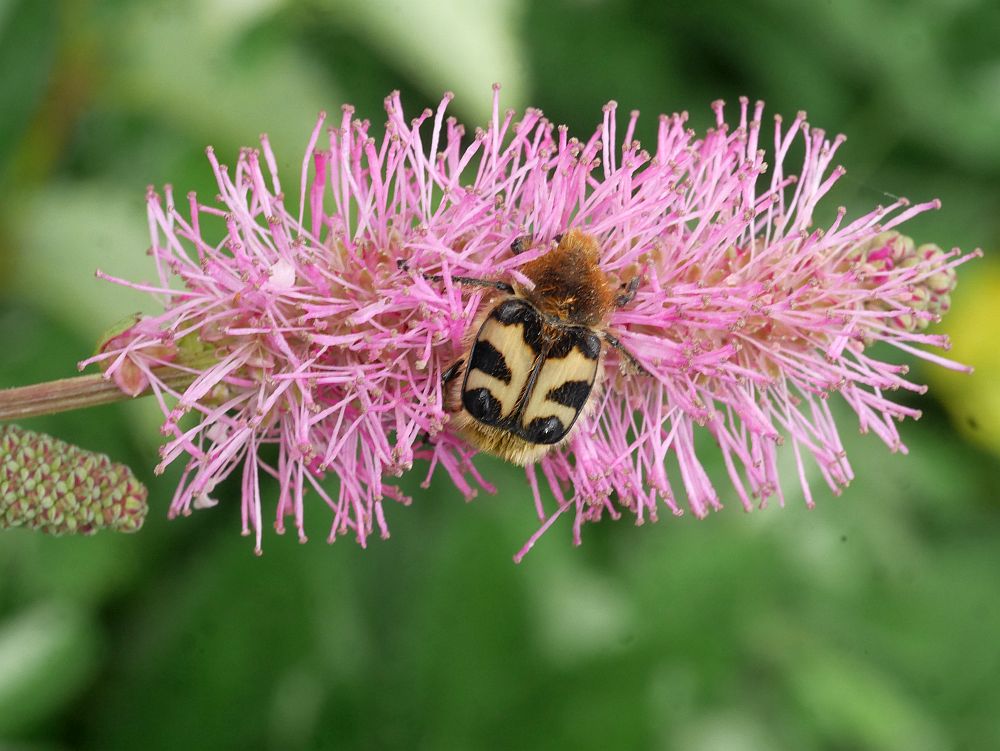
Edimental of the Day is Malva alcea
It is often planted in gardens as it flowers for a long time in summer. It has naturalised in the UK (see https://www.brc.ac.uk/plantatlas/plant/malva-alcea) and also here in Norway there are a number of observations, particularly around Oslo.
This summer, I’ve been using this mallow much more than before as I now have a lot of it and it has replaced moschata in a few places, suggesting that these may be hybrids! This really is one of the most useful perennial vegetables in the summer garden. Along with other mallows you can pick off leaves, young flower buds and flowers over an extended period! I use them in various stir-fry dishes, in soups, on pizza, in quiches and mixed salads!
It is surprisingly not often mentioned as edible in ethnobotanical studies (maybe underreported due to confusion with moschata?). However, a quick search revealed it being used traditionally in Czechoslovakia and Bulgaria!
If I had written my book today, this may well have replaced moschata. I did mention alcea in the book under the account of moschata as follows:
I have less experience with Malva alcea, greater musk mallow, which is, as the English name suggests, a larger plant. It has a similar range to musk mallow, except that it isn’t found in the UK. I’ve only grown the form ‘Fastigiata’ which is long-lived and a nice ornamental, needing staking up during the summer. My plant was sterile and is
thought possibly to be a hybrid between M. alcea and M. moschata. The flowers are also good in salads.
Bees love it too!
Here are a few pictures of it in the garden today:
Butterfly prefers onion to butterfly bush!
Buddleja isn’t edible, but it is one of the best entomentals (insects love them and so do we; it would be an edi-ento-mental if it had also been edible!)
Opium poppy season is here again
I collect the seed for using on bread (see the latter album and http://www.edimentals.com/blog/?page_id=3191) and other baked dishes!
However, great and blue tits compete with me for the seeds, see my blog post on my narcotits (narkomeis)! The flowers are almost certainly perfectly safe to eat raw, at least in small amounts and you’ll see the occasional flower in my salads.
Papaver somniferum is also one of the favourite plants for pollinating insects such as bumblebees, hoverflies etc., see http://www.edimentals.com/blog/?p=12787!
Other poppy species have also been used traditionally for food and even the leaves of corn poppy (kornvalmue) are used in the Mediterranean countries (I remember seeing the leaves for sale in a market in Venice some years ago!
More about the uses of poppies from Cornucopia II. I grow all 3 in my garden here in Malvik!
Papaver somniferum – opium poppy (opiumvalmue). The seeds, called maw seeds in Europe and khas-khas in the Middle East, are widely used in breads, cakes, rolls, milky soups, rice dishes, stews, curries, saladdressings, and sweetmeats. When crushed and sweetened, they are used as a filling for crepes, strudels, pastries, etc. Poppy-seed oil is used like olive oil in French cooking, where it is known as olivette. A paste made from poppy-seed oil and roasted, ground poppy seed is widely used in Turkish cuisine.
Papaver orientale – oriental poppy (orientvalmue). Unripe capsules, though very acrid and hot in taste, are reportedly eaten as a delicacy. In Turkey, the seeds and flower parts are eaten.
Papaver rhoeas – Corn poppy (kornvalmue). Young leaves are cooked and seasoned like spinach, or used as a flavoring in soups and salads. A syrup prepared from the scarlet flower petals has been employed as an ingredient in soups and gruels. They also yield a red pigment used for coloring, especially wine. The seeds are used in cakes, breads, and rolls or pressed for their oil, an excellent substitute for olive oil.
Pink Hogweed

More here:
Rampions for dinner: one of the best edientomentals!
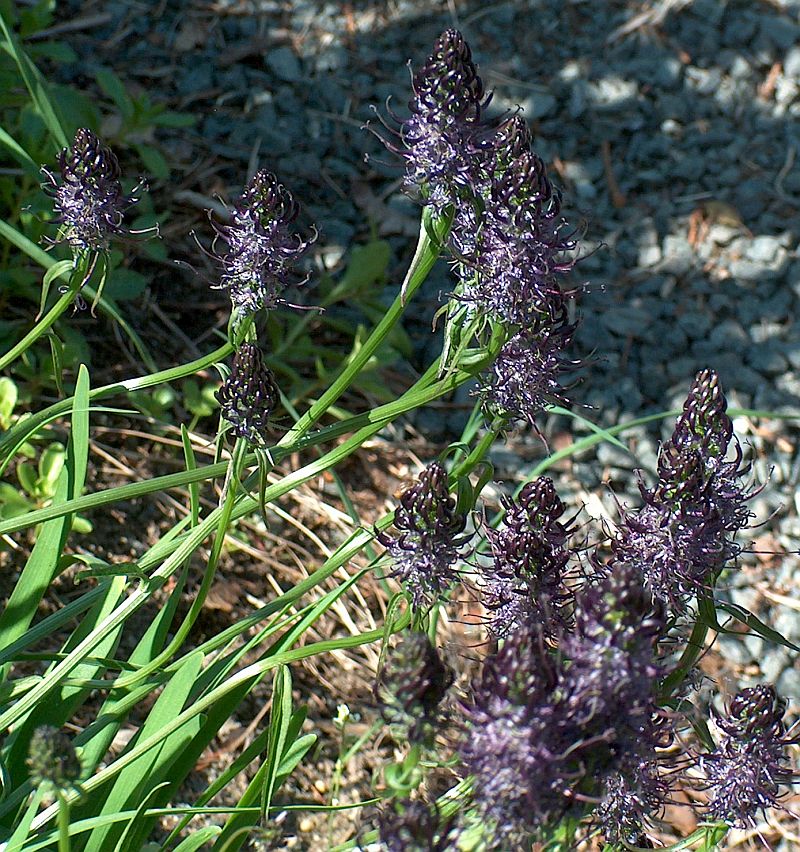
It has self-sowed freely and seems to have crossed with other accessions of Phyteuma spicata with white and blue (ssp. caeruleum) flowers that I have in my garden (these have not self-sowed much) as there is now a mix of colours in the original spot I planted nigrum. Phyteuma spicatum/nigra is also the most popular bee plant in my garden in mid-June and a great edimental (one of the edi-entomentals, plants combining food, ornament as well as good for bees and other pollinators!). Phyteuma spicatum (rapunsel) is a very old root vegetable in Europe, mentioned already in Gerard’s Herball from 1597, but best known as a vegetable in France and Germany! The name rapunsel is related to rapa (turnip) due to its use as a root vegetable!
See my blog post from 23rd June 2017 with pictures and video of black rampion: http://www.edimentals.com/blog/?p=11910
I tried Phyteuma spicatum as a root vegetable in 2013 and was struck by its good sweetish taste:
I harvested a lot of plants this week (late July 2018) while remaking the bed where it was growing and was impressed by the good size of roots and yields, although it is unknown how old the individual plants were (I plan to grow some of the smaller plants elsewhere to see how quickly they grow in a shady area of the garden, as this could be a good forest garden plant, although, like Jerusalem artichoke, plants in the Campanulaceae to which Phyteuma belongs, contain the diabetic friendly but poorly digestable carbohydrate inulin):
The flower heads can also be used as a vegetable, reminiscent of Bath Asparagus flower heads (Ornithogalum pyrenaicum) see the picture from its wiki page:

I saw the plant in the wild for the first time in Austria in the Alps on my Arche Noah tour in 2017 (see http://www.edimentals.com/blog/?p=11483), the white flowered form, growing in open woodlands.
In Norway, it grows wild a few places in southern Norway and has also naturalised in parks, including the great garden at Baroniet Rosendal (see the video and pictures at http://www.edimentals.com/blog/?p=15680). It is also found in the far north of Norway in Finnmark where it naturalised during World War II, introduced by the Germans with horse forage!
The name rapunsel is related to rapa (turnip) due to its use as a root vegetable!
http://www.edimentals.com/blog/?p=11910 (with video)
Other European languages: Raiponce en épi (French), ährige Teufelskralle (German), ährige Rapunzel (Swiss German), and Raponzolo giallo (Italian)
I’ll be offering seed this autumn via Norwegian Seed Savers (KVANN):

